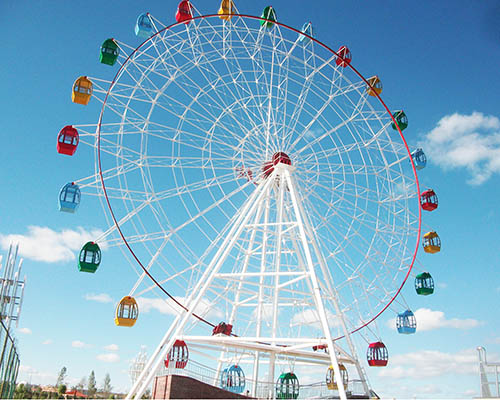Investing in a Ferris wheel ride can be a significant financial commitment, with the average price around $300,000. While renting might be an option for short-term events, fair organizers often prefer buying due to the Ferris wheel’s enduring appeal and popularity. Various factors influence the cost of a Ferris wheel, and understanding these can help in making an informed decision. Let’s explore the key factors that contribute to the price of a Ferris wheel ride.
1. Height of the Ride
The height of a Ferris wheel is one of the most significant factors affecting its price. Ferris wheels come in various heights, typically ranging from 5 meters to a towering 170 meters. The correlation between height and cost is straightforward: the taller the Ferris wheel, the higher the price.
- Small Ferris Wheels (5-15 meters): These are generally designed for younger children and smaller events. They are less expensive but also less versatile in terms of the audience they attract.
- Medium Ferris Wheels (30-45 meters): These cater to a broader age range, including both children and adults. They strike a balance between cost and capacity, making them popular choices for medium-sized fairs and events.
- Large Ferris Wheels (50-170 meters): These are iconic and often serve as major attractions. They can accommodate more people and offer stunning views, justifying their higher price tags. These are best suited for large-scale events or permanent installations in theme parks.
When choosing a Ferris wheel, consider the demographic of your audience. If your primary visitors are families with children, a medium-sized wheel might be ideal. For venues expecting more adult visitors, a larger Ferris wheel can provide a more thrilling experience.

2. Type of Ferris Wheel
The type of Ferris wheel also plays a crucial role in determining its price. Ferris wheels (колесо обозрения купить) come in various designs, each with different features and price points:
- Single-face Mini Ferris Wheel: These are smaller and simpler in design, making them more affordable. They are ideal for children’s amusement parks or smaller fairs.
- Carnival Ferris Wheel: These are medium-sized wheels commonly seen at fairs and carnivals. They offer a classic Ferris wheel experience and are moderately priced.
- Big and Giant Ferris Wheels: These are large structures designed for significant events or permanent installations. Their size and the complexity of their design make them more expensive.
- Double-face Ferris Wheel: These have two sides with cabins, effectively doubling the capacity and offering a unique experience. They are costlier due to their increased capacity and intricate design.
Additionally, Ferris wheels can be classified into traditional and no-spoke designs. Traditional Ferris wheels feature a central axis with spokes radiating outwards, while no-spoke Ferris wheels, which resemble a giant ring, offer a more modern aesthetic. The latter typically costs more due to their innovative design and engineering requirements.
3. Ferris Wheel Mechanism
The operational mechanism of a Ferris wheel significantly influences its price and maintenance costs. Ferris wheels generally operate using either mechanical or hydraulic systems:
- Mechanical Ferris Wheels: These are the most common and preferred due to their reliability and smooth operation. They utilize gears and motors to rotate the wheel, ensuring a stable ride experience. The robust and straightforward design makes them a popular choice for many fair organizers.
- Hydraulic Ferris Wheels: Although once common, hydraulic systems are becoming outdated. These Ferris wheels use hydraulic pumps and pistons to move the wheel. However, they can struggle to support the weight of modern, larger cabins, making them less safe and less desirable. Mechanical systems are recommended for their modern safety standards and operational efficiency.
4. Special Ferris Wheels
Some Ferris wheels are designed for specific purposes beyond traditional carnival rides (купить атракцион). These special Ferris wheels can significantly vary in price due to their unique features and applications:
- Observation Wheels: Often found in tourist destinations, these Ferris wheels are larger and provide panoramic views of the surrounding area. They feature spacious, comfortable cabins with large windows for sightseeing. These wheels are typically more expensive due to their size, luxurious cabins, and the enhanced safety features required for continuous operation.
- Custom Themed Ferris Wheels: Some Ferris wheels are designed to match specific themes or branding requirements. This customization can include unique cabin designs, lighting effects, and thematic decorations, adding to the overall cost.
Making an Informed Purchase
When purchasing a Ferris wheel, it’s essential to compare different models and their prices meticulously. Here are a few tips to help you make a well-informed decision:
- Compare Heights: If a 45-meter Ferris wheel is only slightly more expensive than a 42-meter one, it might be worth investing in the taller model for the enhanced experience and capacity it offers.
- Assess Capacity: Check how many passengers each cabin can accommodate and the total capacity of the wheel. Higher capacity can translate to more ticket sales and better ROI.
- Evaluate Safety Features: Ensure the Ferris wheel meets all safety regulations and includes modern safety features to protect riders.
- Consider Long-term Costs: Factor in the maintenance, operation, and potential repair costs over time. A cheaper initial purchase might incur higher long-term costs if it requires frequent repairs.
By carefully evaluating these factors, you can ensure that you invest in a Ferris wheel that meets your operational needs, budget constraints, and safety standards, providing a valuable and enjoyable attraction for your fair or amusement park (дизайн парка).